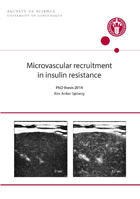PhD defence: Microvascular recruitment in insulin resistance
Kim Anker Sjøberg
PhD thesis
In this PhD work a new method for measuring perfusion of skeletal muscle (microvascular recruitment) was developed and evaluated, using continues real-time imaging of contrast enhanced ultrasound. This method was applied to investigate the vaso-active effect of both insulin and the incretin hormone glucagon-like-peptide-1 (GLP-1) in the microcirculation. Glucagon-like-peptide-1 analogs are drugs used for treatments of insulin resistance and type 2 diabetes but the vascular effects of GLP-1 in vivo are elusive.
Here we observed, like insulin, GLP-1 increased microvascular recruitment but unlike insulin no direct effect on muscle glucose uptake of GLP-1 was observed.
More about the thesis
In this PhD work a new method for measuring microvascular recruitment was developed and evaluated, using continues real-time imaging of contrast enhanced ultrasound. Gas-filled microbubbles were infused intravenously and by taking advantage of the echogenic properties of the microbubbles the resonating sound from the microbubbles in the systemic circulation were recorded for determination of microvascular recruitment in designated muscle segments.
Results showed that microvascular recruitment increased with insulin stimulation by ~30% in rats and ~40% in humans (study I). Furthermore, it was observed that muscle contractions increased muscle perfusion rapidly by 3-4 fold and by 1-2 fold compared to basal and insulin, respectively, in both rat and human skeletal muscle (study I).
The real-time contrast-enhanced ultrasound method was applied to investigate the vaso-active effect of the incretin hormone glucagon-like-peptide-1 (GLP-1) in the microcirculation. Glucagon-like-peptide-1 analogs are drugs used for treatments of insulin resistance and type 2 diabetes but the vascular effects of GLP-1 in vivo are elusive.
Here it was shown that GLP-1 rapidly increased the microvascular recruitment in human and rat skeletal muscle by ~60% and ~30%, respectively, and independently of insulin (study II and III). However, when rats consumed a 60 E% high fat diet acute administration of GLP-1 ameliorated both the early (5 days) and the more prolonged (8 weeks) high fat diet induced impairment of insulin action in the microvasculature and restored normal microvascular function by increasing the microvascular recruitment similar to in control animals. This effect of GLP-1 on microvascular recruitment was associated with a restoration of both whole body insulin sensitivity and muscle glucose uptake when co-infused with insulin in the 5 days but not in the 8 week high fat diet intervention.
Thus, like insulin, GLP-1 increased microvascular recruitment but unlike insulin no direct effect on muscle glucose uptake of GLP-1 was observed.
2014, 103 pages,
ISBN 978 87 7611 751 1
Time
12 June 2014 at 14:00
Venue
Auditorium 1, August Krogh building, Universitetsparken 13, Copenhagen.
Opponents
Professor Ylva Hellsten (chair), Department of Nutrition, Exercise and Sports, University of Copenhagen, Denmark.
Professor Sten Lund, Aarhus University, Denmark.
Professor Etto Eringa, VU University, Netherlands.
Supervisor
Professor Bente Kiens, Department of Nutrition, Exercise and Sports, University of Copenhagen, Denmark.

